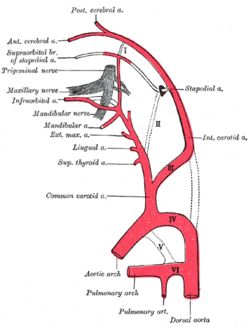Persistent stapedial artery Last updated September 03, 2025 Diagnosis Since most cases of PSA do not present with symptoms, it is usually discovered incidentally upon middle ear surgery , or during postmortem temporal bone dissections . [ 5] The absence of the foramen spinosum is sometimes associated with a PSA, [ 6] although the prevalence of a missing foramen spinosum is much higher than the prevalence of a PSA. [ 7] On the other hand, a foramen spinosum may be present if the maxillomandibular artery originates from the stapedial artery. [ 8] A differential diagnosis can help eliminate other possible conditions such as glomus tumour of the tympanicum , facial nerve schwannoma , and aberrant internal carotid artery (ICA) based on results of high-resolution computed tomograms , angiograms , or magnetic resonance angiograms . [ 9] An aberrant ICA refers to when agenesis of the cervical portion of the ICA occurs, causing the inferior tympanic artery to anastomose with the caroticotympanic artery . This causes the internal carotid artery to enter the middle ear through the same canal as the tympanic nerve , rather than the normal carotid canal. [ 10] Aberrant internal carotid arteries are often found alongside a PSA, [ 1] [ 11] although both anomalies can occur independent of each other. [ 10]
Epidemiology The prevalence of persistent stapedial arteries is thought to be somewhere between 0.02 and 0.48% of the general population; [ 16] [ N 1] a study in the American Journal of Radiology in 2000 stated that only fifty-six cases of PSA had been reported since the first report of PSA was published in 1836 by Austrian anatomist Josef Hyrtl . [ 1]
References 1 2 3 Silbergleit R, Quint DJ, Mehta BA, et al. (March 2000). "The Persistent Stapedial Artery" . American Journal of Radiology . 21 (3): 572– 577. PMC 8174972 . PMID 10730654 . ↑ Sanjuan M, Chapon F, Magnan J (August 2020). "An atypical stapedial artery" . The Journal of International Advanced Otology . 16 (2): 274– 277. doi : 10.5152/iao.2019.4002 . PMC 7419084 . PMID 32510458 . 1 2 Tien HC, Linthicum FH (November 2001). "Persistent Stapedial Artery". Otology & Neurotology . 22 (6): 975– 976. doi :10.1097/00129492-200111000-00044 . PMID 11698828 . 1 2 Santos M, Esteves SS, Pinto A, et al. (15 December 2016). "Clinical Experience of bone-anchored hearing aid in a patient with Persistent Stapedial Artery". Acta Otorrinolaringológica . 9 (1): 140– 145. ISSN 2340-3438 . ↑ Bonasia S, Smajda S, Ciccio G, et al. (September 2020). "Stapedial Artery: From Embryology to Different Possible Adult Configurations" . American Journal of Neuroradiology . 41 (10): 1768– 1776. doi : 10.3174/ajnr.A6738 . PMC 7661070 . PMID 32883664 . ↑ Guinto FC, Garrabrant EC, Radcliffe WB (November 1972). "Radiology of the Persistent Stapedial Artery". Radiology . 105 (2): 365– 369. doi :10.1148/105.2.365 . PMID 5079662 . ↑ Klostranec JM, Krings T (2022). "Cerebral neurovascular embryology, anatomic variations, and congenital brain arteriovenous lesions" . Journal of NeuroInterventional Surgery . 14 (9): 910– 919. doi : 10.1136/neurintsurg-2021-018607 . PMID 35169032 . S2CID 246829491 . ↑ Hitier M, Zhang M, Labrousse M, et al. (2013). "Persistent stapedial arteries in human: from phylogeny to surgical consequences". Surgical and Radiologic Anatomy . 35 (10): 883– 891. doi :10.1007/s00276-013-1127-z . PMID 23640742 . S2CID 21065191 . ↑ Yilmaz T, Bilgen C, Savas R, Alper H (June 2003). "Persistent Stapedial Artery: MR Angiographic and CT Findings" . American Journal of Neuroradiology . 24 (6): 1133– 1135. PMC 8148996 . PMID 12812939 . 1 2 Hatipoglu HG, Cetin MA, Yuksel E, et al. (May 2011). "A case of a coexisting aberrant internal carotid artery and persistent stapedial artery: The role of MR angiography in the diagnosis" . Ear, Nose & Throat Journal . 90 (5): 17– 20. doi : 10.1177/014556131109000513 . PMID 21563075 . ↑ Sullivan AM, Curtin HD, Moonis G (February 2019). "Arterial Anomalies of the Middle Ear: A Pictorial Review with Clinical-Embryologic and Imaging Correlation". Neuroimaging Clinics of North America . 29 (1): 93– 102. doi :10.1016/j.nic.2018.09.010 . PMID 30466646 . S2CID 53716332 . ↑ Quarte R, Manipoud P, Schmerber S (June 2019). "Persistent stapedial artery in PHACE syndrome" . European Annals of Otorhinolaryngology, Head and Neck Diseases . 136 (3): 215– 217. doi : 10.1016/j.anorl.2019.02.015 . PMID 30876851 . 1 2 Hill FC, Teh B, Tykocinski M (2018). "Persistent Stapedial Artery with Ankylosis of the Stapes Footplate" . Ear, Nose & Throat Journal . 97 (7): 227– 228. doi : 10.1177/014556131809700702 . PMID 30036438 . ↑ Wardrop P, Kerr AI, Moussa SA (September 1995). "Persistent stapedial artery preventing successful cochlear implantation: a case report". The Annals of Otology, Rhinology, and Laryngology . 166 : 443– 445. PMID 7668745 . ↑ Jones H, Hintze J, Gendre A, et al. (2022). "Persistent Stapedial Artery Encountered during Cochlear Implantation" . Case Reports in Otolaryngology . 2022 : 1– 3. doi : 10.1155/2022/8179062 . PMC 8888055 . PMID 35242393 . 1 2 Moreano EH, Paparella MM, Zelterman D, et al. (2 March 1993). "Prevalence of facial canal dehiscence and of persistent stapedial artery in the human middle ear: A report of 1000 temporal bones". The Laryngoscope . 104 (3 Pt 1): 309– 320. doi :10.1288/00005537-199403000-00012 . PMID 8127188 . S2CID 10575546 . ↑ Jehl J, Jeunet L, Berraiah M, et al. (2006). "Bilateral Persistent Pharyngo-Stapedial Arteries Revealed during Evaluation of a Carotid-Cavernous Fistula" . Interventional Neuroradiology . 12 (4): 327– 334. doi :10.1177/159101990601200406 . PMC 3354603 . PMID 20569590 .
This page is based on this
Wikipedia article Text is available under the
CC BY-SA 4.0 license; additional terms may apply.
Images, videos and audio are available under their respective licenses.

